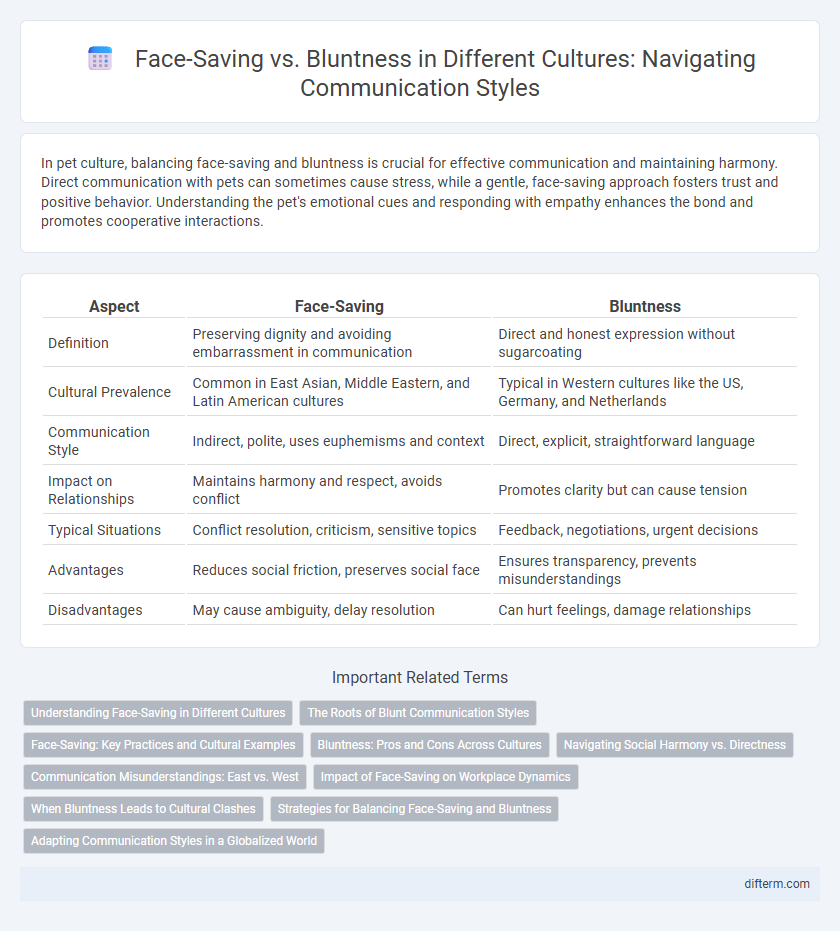In pet culture, balancing face-saving and bluntness is crucial for effective communication and maintaining harmony. Direct communication with pets can sometimes cause stress, while a gentle, face-saving approach fosters trust and positive behavior. Understanding the pet's emotional cues and responding with empathy enhances the bond and promotes cooperative interactions.
Table of Comparison
| Aspect | Face-Saving | Bluntness |
|---|---|---|
| Definition | Preserving dignity and avoiding embarrassment in communication | Direct and honest expression without sugarcoating |
| Cultural Prevalence | Common in East Asian, Middle Eastern, and Latin American cultures | Typical in Western cultures like the US, Germany, and Netherlands |
| Communication Style | Indirect, polite, uses euphemisms and context | Direct, explicit, straightforward language |
| Impact on Relationships | Maintains harmony and respect, avoids conflict | Promotes clarity but can cause tension |
| Typical Situations | Conflict resolution, criticism, sensitive topics | Feedback, negotiations, urgent decisions |
| Advantages | Reduces social friction, preserves social face | Ensures transparency, prevents misunderstandings |
| Disadvantages | May cause ambiguity, delay resolution | Can hurt feelings, damage relationships |
Understanding Face-Saving in Different Cultures
Face-saving plays a critical role in many Asian cultures, where maintaining social harmony and avoiding direct confrontation are highly valued. In contrast, Western cultures often prioritize bluntness and straightforward communication, viewing it as a sign of honesty and efficiency. Understanding these cultural differences in face-saving helps improve cross-cultural interactions and prevents misunderstandings in both personal and professional settings.
The Roots of Blunt Communication Styles
Blunt communication styles often originate from cultures that prioritize directness and transparency, emphasizing efficiency and clarity over social harmony. These cultures value straightforwardness as a sign of honesty and respect, reducing ambiguity in interactions. The root of bluntness lies in deeply ingrained social norms that favor explicit expression to avoid misunderstandings and misinterpretations.
Face-Saving: Key Practices and Cultural Examples
Face-saving is a crucial practice in many Asian cultures, emphasizing indirect communication and maintaining harmony by avoiding embarrassment or confrontation. In Japan, for instance, the concept of "tatemae" (public behavior) helps individuals preserve face by expressing socially acceptable opinions rather than personal truths. Similarly, in Chinese culture, "mianzi" (face) plays a significant role in interpersonal interactions, where individuals carefully navigate conversations to uphold social respect and group cohesion.
Bluntness: Pros and Cons Across Cultures
Bluntness promotes clear communication by minimizing misunderstandings and encouraging honesty, which can increase efficiency in decision-making within cultures valuing directness such as Germany and the Netherlands. However, it risks offending or alienating individuals in high-context cultures like Japan and Brazil, where indirectness and face-saving are crucial for maintaining social harmony. Balancing bluntness with cultural sensitivity is essential to foster mutual respect and effective cross-cultural interactions.
Navigating Social Harmony vs. Directness
Navigating social harmony in many cultures often involves face-saving strategies that prioritize indirect communication to preserve relationships and avoid conflict. Bluntness, common in more direct cultures, emphasizes clarity and honesty but can risk social friction and perceived rudeness. Understanding the cultural preferences for either face-saving or directness is crucial for effective communication and maintaining interpersonal trust across diverse social contexts.
Communication Misunderstandings: East vs. West
Face-saving is a critical aspect of communication in many East Asian cultures, where indirectness and subtlety help maintain social harmony and avoid public embarrassment. In contrast, Western communication often values bluntness and directness, which can be perceived as honesty and efficiency but may cause misunderstandings or offense in Eastern contexts. These differing communication styles highlight the importance of cultural awareness to prevent misinterpretations and foster effective cross-cultural interactions.
Impact of Face-Saving on Workplace Dynamics
Face-saving in workplace culture fosters harmony by reducing conflict and maintaining interpersonal relationships, thereby enhancing collaboration and morale. Blunt communication, though potentially more efficient in conveying information, can create tension and reduce trust among team members. Emphasizing face-saving strategies leads to a more cohesive and respectful work environment, promoting long-term productivity.
When Bluntness Leads to Cultural Clashes
Bluntness often triggers cultural clashes when direct communication clashes with face-saving norms prevalent in many collectivist societies. In cultures emphasizing harmony, such as Japan and China, preserving social dignity avoids embarrassment and maintains group cohesion. Failure to navigate these differences can result in misunderstandings, damaged relationships, and decreased collaboration in multinational settings.
Strategies for Balancing Face-Saving and Bluntness
Effective communication in diverse cultural settings often requires balancing face-saving and bluntness by employing tactful strategies such as using indirect language to soften critiques while maintaining clarity. Leveraging positive reinforcement alongside constructive feedback helps preserve relationships and fosters mutual respect in professional and social interactions. Culturally aware communicators adjust their approach by reading social cues and adapting messages to avoid causing embarrassment or offense, ensuring messages are impactful without being confrontational.
Adapting Communication Styles in a Globalized World
Adapting communication styles in a globalized world involves balancing face-saving strategies with bluntness to navigate cultural differences effectively. Face-saving is crucial in high-context cultures where indirect communication preserves harmony and respect, while bluntness is often more accepted in low-context cultures that value directness and clarity. Understanding these nuances allows for more effective cross-cultural interactions, reducing misunderstandings and fostering mutual respect in international business and social environments.
face-saving vs bluntness Infographic

 difterm.com
difterm.com